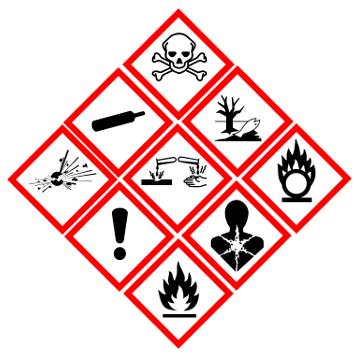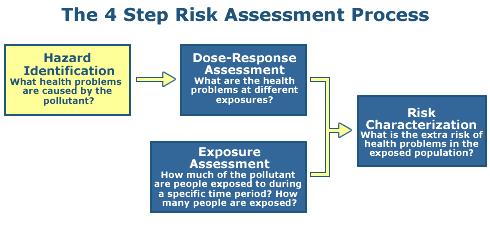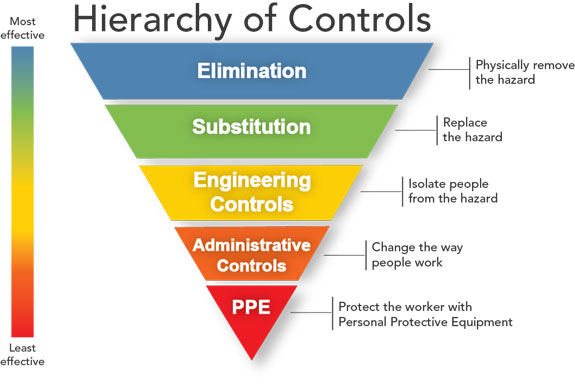
A subject that comes up frequently in the context of managing and choosing chemicals, particularly for downstream users, is that of hazard and risk. With this piece we start what will be a series on the topic, particularly as it applies to considerations and questions that arise in the process of choosing safer chemicals.
The obvious place to begin is by defining “hazard” and “risk” in the context of chemicals. Outside of this context, the common dictionary definition for hazard uses these terms as if they were synonymous and interchangeable. But when discussing chemical toxicity – particularly in relation to chemicals management and regulation – there are important distinctions between hazard and risk.
Within this framework, hazard refers to a substance’s potential to cause adverse health or environmental effects. Hazard is thus an inherent or intrinsic characteristic of that substance. That a substance is hazardous means the chemical has characteristics that can cause adverse effects but says nothing specific about how likely that harm is to occur.
The obvious place to begin is by defining “hazard” and “risk” in the context of chemicals. Outside of this context, the common dictionary definition for hazard uses these terms as if they were synonymous and interchangeable. But when discussing chemical toxicity – particularly in relation to chemicals management and regulation – there are important distinctions between hazard and risk.
Within this framework, hazard refers to a substance’s potential to cause adverse health or environmental effects. Hazard is thus an inherent or intrinsic characteristic of that substance. That a substance is hazardous means the chemical has characteristics that can cause adverse effects but says nothing specific about how likely that harm is to occur.
 On the other hand, risk cannot exist without hazard and in the context of chemicals management, risk is defined as a function of hazard and exposure. Determining the risk a chemical poses means assessing the likelihood that harm will be caused by exposure to a hazardous substance. And exposure can vary in different ways: by amount (the level, concentration, or dose); by duration; by timing – exposure at a critical or vulnerable point in development or biological process; by route or pathway (was a substance inhaled, ingested or touched, for example); and by combination with exposure to other stressors, chemical or other, that may be affecting human or environmental health.
On the other hand, risk cannot exist without hazard and in the context of chemicals management, risk is defined as a function of hazard and exposure. Determining the risk a chemical poses means assessing the likelihood that harm will be caused by exposure to a hazardous substance. And exposure can vary in different ways: by amount (the level, concentration, or dose); by duration; by timing – exposure at a critical or vulnerable point in development or biological process; by route or pathway (was a substance inhaled, ingested or touched, for example); and by combination with exposure to other stressors, chemical or other, that may be affecting human or environmental health.
Source: http://www.corner-enviro.com/ghs/
All of these considerations are essential for understanding the risk a hazardous substance may pose. It’s also important to remember that even if no one or no environment is exposed to a hazardous substance – or an assessment determines that risk is low – that substance remains hazardous. Because chemical management and regulation typically rely on risk assessments to set safety standards – what exposure to a hazardous substance is considered to be without unacceptable adverse health or environmental effects – hazard and risk are easily confused.
The confusion of hazard and risk is amply evident in the response to the recent International Agency for Research on Cancer (IARC) classification of glyphosate – the active ingredient in the herbicide sold in numerous weed-killing products, including Roundup – as a “probable human carcinogen.” The IARC assessments are hazard assessments not risk assessments. To arrive at their conclusions about whether or not a substance is potentially carcinogenic, IARC committees review existing scientific literature on a substance’s health effects and toxicity: animal studies, cell culture studies, and human epidemiological studies. The classifications reflect IARC’s judgment – based on this evidence – that a substance has the potential to cause cancer. They do not, however, specify the circumstances under which cancer might occur or its statistical likelihood of occurring; that would be a risk assessment.
Risk assessments must include studies that evaluate a substance’s toxicity or inherent hazards but a risk assessment can conclude that it is acceptable or otherwise okay to be exposed to a certain amount of a hazardous substance under certain circumstances without denying that substance’s toxicity. In other words, deciding that a limited exposure to a hazardous substance is acceptable does not mean that the substance itself is “safe” or non-toxic.
However, in responding to the IARC glyphosate classification, the chemical’s manufacturers and trade associations representing agricultural chemical producers and users have focused on risk. The European and US government agency assessments these groups have cited as evidence of the chemical’s safety are risk assessments: evaluations designed to determine how likely it is that exposure will result in cancer or other adverse health effects.
The confusion of hazard and risk is amply evident in the response to the recent International Agency for Research on Cancer (IARC) classification of glyphosate – the active ingredient in the herbicide sold in numerous weed-killing products, including Roundup – as a “probable human carcinogen.” The IARC assessments are hazard assessments not risk assessments. To arrive at their conclusions about whether or not a substance is potentially carcinogenic, IARC committees review existing scientific literature on a substance’s health effects and toxicity: animal studies, cell culture studies, and human epidemiological studies. The classifications reflect IARC’s judgment – based on this evidence – that a substance has the potential to cause cancer. They do not, however, specify the circumstances under which cancer might occur or its statistical likelihood of occurring; that would be a risk assessment.
Risk assessments must include studies that evaluate a substance’s toxicity or inherent hazards but a risk assessment can conclude that it is acceptable or otherwise okay to be exposed to a certain amount of a hazardous substance under certain circumstances without denying that substance’s toxicity. In other words, deciding that a limited exposure to a hazardous substance is acceptable does not mean that the substance itself is “safe” or non-toxic.
However, in responding to the IARC glyphosate classification, the chemical’s manufacturers and trade associations representing agricultural chemical producers and users have focused on risk. The European and US government agency assessments these groups have cited as evidence of the chemical’s safety are risk assessments: evaluations designed to determine how likely it is that exposure will result in cancer or other adverse health effects.

In the US, the Environmental Protection Agency (EPA) bases its chemical safety standards on risk assessments as do the Food and Drug Administration (FDA) and Consumer Product Safety Commission. For these regulatory authorities – and others around the world – it is not inconsistent that a potentially carcinogenic substance would be allowed to be used in manufacturing processes and consumer or industrial products. The circumstances of exposure deemed “safe” or acceptable are typically determined in a risk assessment. And again, the “safe” or acceptable exposure level does not erase the substance’s inherent toxicity.
We have air quality and drinking water standards based on risk assessments for scores of hazardous substances that may be present in ambient air and household water supplies. And when it comes to manufactured products, companies and governments constantly generate risk assessments for chemicals in finished products. The current debate over formaldehyde regulation in wood and other building materials, flame retardants in upholstery foams, and highly fluorinated chemicals in consumer products are but several examples.
We have air quality and drinking water standards based on risk assessments for scores of hazardous substances that may be present in ambient air and household water supplies. And when it comes to manufactured products, companies and governments constantly generate risk assessments for chemicals in finished products. The current debate over formaldehyde regulation in wood and other building materials, flame retardants in upholstery foams, and highly fluorinated chemicals in consumer products are but several examples.
Yet another example that helps illustrate the distinction between hazard and risk comes from occupational health and safety – what’s called the hierarchy of controls. As the US National Institute of Occupational Safety and Health (NIOSH) explains, “The idea behind this hierarchy is that the control methods at the top of graphic are potentially more effective and protective than those at the bottom.” The measure at the top of this list is: eliminate the hazard. After that comes replacing the hazard with a safe (even better than a “safer”) technology. But after that, the measures move on to what amounts to risk reduction: keeping people away from the hazard, changing the way people work to reduce exposure to the hazard, and lastly, allowing workers to be exposed to the hazard while wearing personal protective equipment.

Hazard elimination is also fundamental to the principles of green chemistry. These principles maintain that the best way of preventing toxic exposures and harmful pollution is by not creating substances that are inherently toxic – whether to human health or the environment – and do not result in toxic by-products or waste. This idea has been extended to product design as manufacturers seek to create products (and manufacturing processes) that are free from hazardous substances, and thus eliminate or reduce risk of harm to the environment or human health throughout the product’s life cycle.
While our governments regulate chemicals overwhelmingly on risk control -- setting the parameters under which a hazardous substance may be used and establishing acceptable levels of risk – these programs do not protect downstream users from the market risks and liabilities of hazardous chemicals in their products and manufacturing operations. Future Trending Topics will examine the strengths and weaknesses for downstream users in managing chemicals using hazard- and risk-based approaches.


